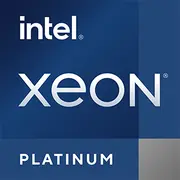Intel Xeon Platinum 8580

The Intel Xeon Platinum 8580 processor is a powerhouse designed for server use. With a total of 60 cores and 120 threads, this processor delivers exceptional multi-threaded performance, making it ideal for demanding workloads and applications. The 10 nm technology ensures efficiency and power savings, despite the high core count.
The base frequency of 2 GHz can handle everyday tasks with ease, but where the Platinum 8580 truly shines is with its max turbo frequency of 4 GHz, providing incredible bursts of speed when needed. The massive 300 MB of L3 cache ensures that data can be accessed quickly, further boosting performance.
With a TDP of 350W, the processor does consume more power than some others on the market, but the performance it offers more than justifies it, especially for data center and enterprise applications. The Emerald Rapids architecture delivers on Intel's promise of high performance and reliability, making the Xeon Platinum 8580 a top choice for businesses in need of uncompromising power and speed. Overall, the Intel Xeon Platinum 8580 processor is a top-of-the-line option for data-intensive tasks, providing exceptional performance and reliability for demanding server workloads.
Basic
Label Name
Intel
Platform
Server
Launch Date
December 2023
Model Name
?
The Intel processor number is just one of several factors - along with processor brand, system configurations, and system-level benchmarks - to be considered when choosing the right processor for your computing needs.
Xeon Platinum 8580
Code Name
Emerald Rapids
Foundry
Intel
Generation
Xeon Platinum (Emerald Rapids-SP)
CPU Specifications
Total Cores
?
Cores is a hardware term that describes the number of independent central processing units in a single computing component (die or chip).
60
Total Threads
?
Where applicable, Intel® Hyper-Threading Technology is only available on Performance-cores.
120
Performance-core Base Frequency
2 GHz
Performance-core Max Turbo Frequency
?
Maximum P-core turbo frequency derived from Intel® Turbo Boost Technology.
4 GHz
L1 Cache
80 KB per core
L2 Cache
2 MB per core
L3 Cache
300 MB shared
CPU Socket
?
The socket is the component that provides the mechanical and electrical connections between the processor and motherboard.
Intel Socket 4677
Unlocked Multiplier
No
Bus Frequency
100MHz
Multiplier
20.0
Technology
?
Lithography refers to the semiconductor technology used to manufacture an integrated circuit, and is reported in nanometer (nm), indicative of the size of features built on the semiconductor.
10 nm
TDP
350 W
Max. Operating Temperature
?
Junction Temperature is the maximum temperature allowed at the processor die.
81 °C
PCIe Version
?
PCI Express is a high-speed serial computer expansion bus standard used for connecting high-speed components, replacing older standards such as AGP, PCI, and PCI-X. It has gone through multiple revisions and improvements since its initial release. PCIe 1.0 was first introduced in 2002, and in order to meet the growing demand for higher bandwidth, subsequent versions have been released over time.
5
Memory Specifications
Memory Type
?
Intel® processors come in four different types: Single Channel, Dual Channel, Triple Channel, and Flex Mode. Maximum supported memory speed may be lower when populating multiple DIMMs per channel on products that support multiple memory channels.
DDR5-5600
Memory Channels
?
The number of memory channels refers to the bandwidth operation for real world application.
8
ECC Memory Support
Yes
GPU Specifications
Integrated Graphics Model
?
An integrated GPU refers to the graphics core that is integrated into the CPU processor. Leveraging the processor's powerful computational capabilities and intelligent power efficiency management, it delivers outstanding graphics performance and a smooth application experience at a lower power consumption.
N/A
Miscellaneous
PCIe Lanes
80
Share in social media
Or Link To Us
<a href="https://cputronic.com/en/cpu/intel-xeon-platinum-8580" target="_blank">Intel Xeon Platinum 8580</a>